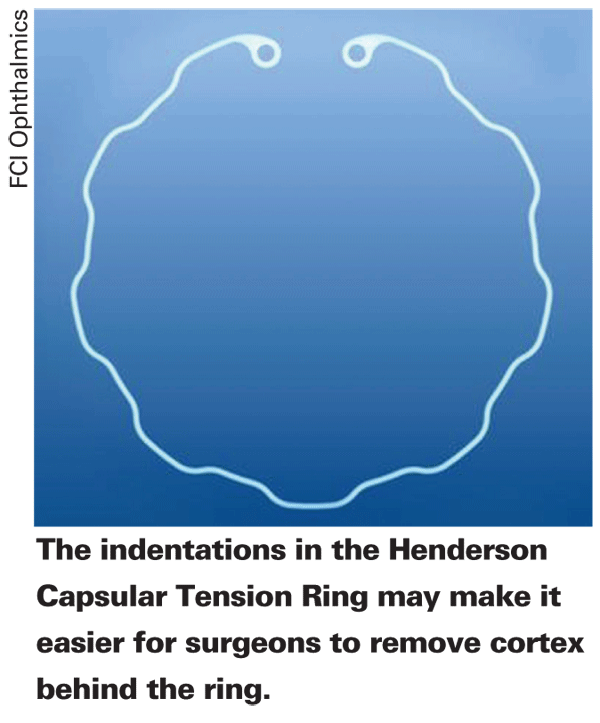The advent of capsular tension rings has been a boon to many cataract surgeons, making it easier to stabilize the capsule in certain problematic eyes. However, these rings can get in the way of cortical cleanup, trapping cortex behind them as they exert their tension outward. A new design modification by
The Henderson Capsular Tension Ring is made of PMMA like the original, and is an open, C-shaped loop. The difference is that, instead of being round, it's got eight 0.15-mm indentations around its circumference. Working with it, however, is the same as a normal Morcher CTR (FCI Ophthalmics), says Dr. Henderson. "You can still inject it through the same injector system or place it manually," she says. Dr. Henderson has no financial interest in the ring or Morcher.
During the surgery, the ophthalmologist places an HCTR and then proceeds normally. "There are actually two options," says Dr. Henderson. "One involves not manipulating the ring at all. Once the ring is placed, you go about removing the cortex as you normally would, though you may find it easier. The second op-tion is, after you remove the cortex in the areas under the ring's indentations, where it's easier to remove, you actually rotate the HCTR so the portions that aren't indented move over to the clear areas. Then, the indentations are over areas of cortex that you can then remove more easily. You rotate the ring by putting an instrument such as a Sinskey hook in the eyelet on the ring's end."
Dr. Henderson undertook a pig-eye study to gauge the effectiveness of her modified CTR. In the study, a colleague performed a capsulorhexis on one of the eyes and placed a StabilEyes (AMO) capsular tension ring (three eyes), a Morcher 14C CTR (one eye) or an HCTR (four eyes). Dr. Henderson, masked as to which ring was in the eye, then finished the case, performing phacoemulsification and cortical removal. "Once a ring is placed, you can't see which one it is unless you lift the iris to look," explains Dr. Henderson. The researchers recorded the total surgical time, effective phaco time and average irrigating BSS used. They found that the average surgical time was less in the HCTR eyes than the non-HCTR eyes (3.5 minutes vs. eight minutes, p=0.06), as was the effective phaco time (86 sec. vs. 147 sec., p=0.03) and the irrigation volume (75 cc vs. 191 cc, p=0.03).
The Henderson Capsular Tension Ring is currently available in



